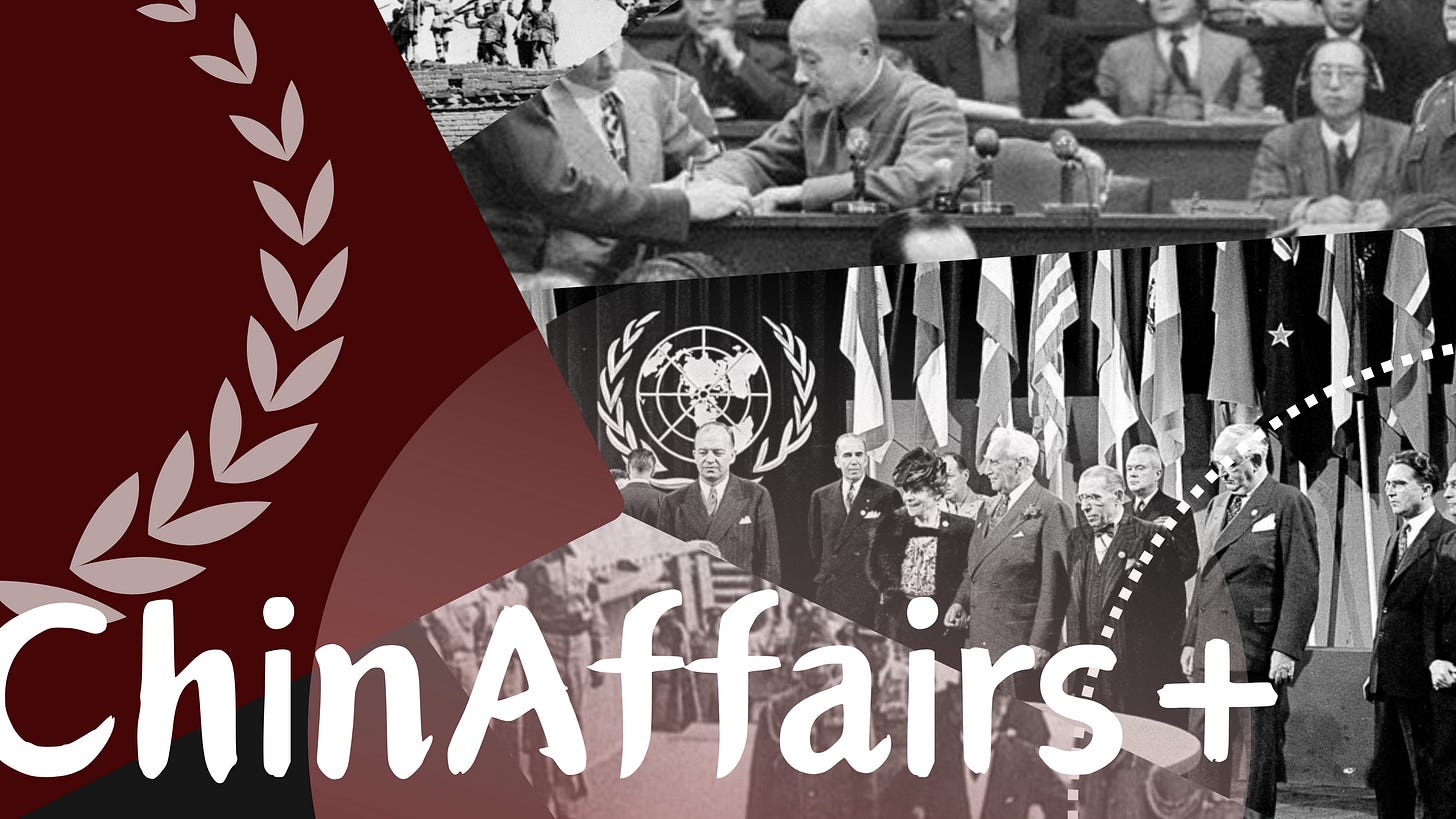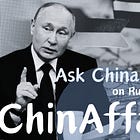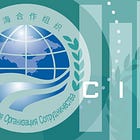#2 Ask China: A Chinese Perspective on the Post-world War International Order
China must skillfully leverage a multipolar mindset to respond to a multipolar world, mobilize great power coordination to maintain stability, and avoid a camp-based mindset.
Welcome to the 51st edition of our weekly newsletter! I'm SUN Chenghao, a fellow with the Center for International Security and Strategy (CISS) at Tsinghua University, Council Member of The Chinese Association of American Studies, a visiting scholar at Paul Tsai China Center of Yale Law School in 2024 and Munich Young Leader 2025.
ChinAffairsplus is a newsletter that shares articles by Chinese academics on topics such as China's foreign policy, China-U.S. relations, China-Europe relations, and more. This newsletter was co-founded by my research assistant, ZHANG Xueyu, and me.
Through carefully selected Chinese academic articles, we aim to provide you with key insights into the issues that China's academic and strategic communities are focused on. We will highlight why each article matters and the most important takeaways. Questions and feedback can be addressed to sch0625@gmail.com.
In this newsletter, we introduce a new section “Ask China” to address concerns about China’s positions through a Q&A format, while also presenting key points of leading Chinese scholars’ commentaries. Through this new series, we aim to provide policymakers, think tanks, and strategic communities overseas with access to Chinese scholars’ views, accompanied by curated academic perspectives that help readers better understand the considerations underlying China’s foreign policy choices.
Background
2025 marks the 80th anniversary of the victory of the Chinese People’s War of Resistance Against Japanese Aggression and the World Anti-Fascist War. The victory of the anti-fascist alliance in World War Two led to the formation of an international system with the United Nations as its core, an international order based on international law, and the basic norms of international relations based on the purposes and principles of the UN Charter. However, in recent years, once-in-a-century-scale world transformations have been occurring more rapidly, and the world has witnessed protracted and intensified geopolitical conflicts, repeated attempts to decouple and sever supply chains, and the rapid rise of the Global South. These phenomena are changing the post-war international order profoundly, and raising an important question: Where will the post-war international order go?
As the pillar of resistance in the main Eastern theatre during the World Anti-Fascist War and a founding member of the UN, China has hosted events on September 3rd to commemorate history as well as mark its intention to defend the post-war international order, which espouses multilateralism, fairness, justice, openness and cooperation throughout the world.
Against this backdrop, today’s Ask China addresses four questions frequently raised abroad: Which aspects of the post-war international order do China believe have been destabilized? Do China, the U.S. and the EU refer to the same ‘multipolarization’? What kind of international order does China aspire to build and what’s China’s role within it? Which international order ‘bottom lines’ need to be protected most, and what historical responsibilities does China bear in upholding them?
By engaging with these questions directly, we aim to offer a clearer picture of China’s perspectives. In addition, we selected and compiled three prominent Chinese scholars’ commentaries, aiming to offer readers a more comprehensive understanding of China’s thinking on the policy front.
Ask China
Post-World War II, the international order has been shaken. Western countries, especially the United States, have gradually shifted from builders of the order to its disruptors. To rebuild a “China‑free” global supply chain, the United States wields tariffs at will, seeking to overturn a multilateral trading system centered on the World Trade Organization, creating an isolated “WTO minus 1” system and placing itself outside of the international order. The frequency of regional and geopolitical conflicts has increased markedly: the crisis in Ukraine, the Israeli‑Palestinian conflict, the India‑Pakistan conflict, and flare‑ups between Israel and Iran have erupted one after another. These tensions expose the current international order’s inadequate capacity to curb war and conflict.
In addition, the risk of a nuclear arms race has intensified; some regional states have stronger ambitions to acquire nuclear weapons; major powers such as the United States are shirking security‑governance responsibilities; the global nuclear arms‑control regime is on the verge of collapse; and the pillars of the international security order are cracking. The above pose serious threats to international peace and stability.
The international community needs to safeguard several fundamental bottom lines most urgently: the shared consensus on questions of war and peace, the principles of sovereignty and equality enshrined in the UN Charter, and the multilateral security and non-proliferation mechanisms centered on the UN Security Council. Upholding these bottom lines prevents the world from sliding back into the “law of the jungle” and ensures the sovereignty and security of all states. China, with a deep understanding of the importance of sovereign security, naturally bears a strong sense of responsibility and initiative in maintaining these foundations.
In carrying out this responsibility, China emphasizes openness in the face of U.S. “China-free” supply-chain restructuring policies, seeking to defend the integrity of economic globalization and the multilateral trading system. At the same time, China acts as a responsible major power by advocating fairness and dialogue in regional conflicts such as the Ukraine crisis and the Israeli-Palestinian conflict, working to prevent escalation and promoting negotiations. China also calls on the five nuclear-weapon states to commit to mutual no-first-use of nuclear arms in order to safeguard strategic stability and nuclear security. Beyond these efforts, China is committed to advancing the construction of a new multipolar world based on peaceful coexistence and equal cooperation. This vision aims to avoid the degeneration of “disordered multipolarity” into bipolar rivalry, provide global security public goods, and ensure lasting world peace.
The notion that the world is moving toward multipolarity has increasingly become a point of international consensus. In January this year, U.S. Secretary of State Rubio remarked in an interview that “unipolar hegemony was an abnormal phenomenon caused by the end of the Cold War, and the world will ultimately return to a multipolar structure.” Yet different actors interpret multipolarity in different ways.
For China, multipolarity means a new type of international order in which multiple centers of power coexist peacefully, treat one another as equals, and engage in cooperation guided by multilateralism. This understanding leans toward inclusiveness and resonates with the concept of a “community with a shared future for mankind.” In Europe, multipolarity is viewed as an acknowledgment of declining hegemony and a call for multilateralism, but one that still seeks to preserve Western primacy. Europe’s interpretation often emphasizes a normative, Western-led “multilateralism,” highlights the transatlantic bond, and underscores Europe’s role as an independent “pole.”
The American perspective, by contrast, tends to highlight the rise of multiple powers as a threat to U.S. hegemony. This reflects a deep anxiety about the erosion of its dominant position. From Washington’s standpoint, a more dispersed and unstable international order would constrain U.S. policy options, undermine its global standing, and damage its national interests. Hence, the United States continues to insist on its role as the world’s leader.
In short, while China and Europe both invoke “multipolarity” in support of multilateralism, they diverge over the question of who should lead the international order. The United States, meanwhile, generally views multipolarity in negative terms.
China envisions the establishment of an equal and orderly multipolar international order, the core features of which include the following. The first feature is the multipolar balance of power. This new order should rest on the foundation of balanced multipolarity. In fact, the trend toward world multipolarity is irreversible. The collective rise of the Global South, alongside the growing influence of regionally integrated organizations such as the EU, is fundamentally reshaping the global distribution of power. Thus, the ability of a single hegemon to dominate global affairs and its legitimacy in doing so are waning. However, without management and coordination, the multipolar process risks descending into disorder, conflict, or even war. China emphasizes the importance of orderly transition, ensured through a set of mechanisms, the key aspects of which are shared below. The second feature is equality among states, which means that all countries, regardless of size or strength, should respect each other’s sovereignty and territorial integrity, adhere to the purposes and principles of the UN Charter, and oppose hegemonism and power politics. The third feature is common security, which requires upholding a vision of common, comprehensive, cooperative, and sustainable security. The fourth feature is balanced development, which entails promoting an open world economy, narrowing the North—South divide, and ultimately achieving shared prosperity. The final feature is diversity of civilizations, which implies respecting differences in civilizations and development paths, while encouraging mutual learning and dialogue among cultures.
As for its envisioned role in this order, Li argues that China will be an advocate for, contributor to and coordinator for this blueprint. In this new international order, China seeks to realize the vision of building a community with a shared future for mankind, promote the reform of the global governance system, and inject greater certainty into international relations. As a contributor, China will continue to provide global public goods through initiatives such as the Belt and Road Initiative, fostering infrastructure connectivity and sustainable development. Finally, as a coordinator, China will emphasize dialogue and consultation in international affairs, assume the responsibilities of a major power, mediate regional conflicts, and safeguard peace and stability.
In all, China positions itself as a supporter, not a disruptor or subverter, of the international order. It seeks to reform the unjust aspects of the current system—especially those that constrain the voice of emerging markets and developing countries. The ultimate goal is the realization of an international order marked by common prosperity among all nations.
China Scholars’ Insights
Da Wei: China is Bound to Shoulder a Greater Historic Responsibility in Advancing the Reform of the International Order
The realist international order gradually matured following the formation of the Westphalian system. After World War II, liberal ideas, supported by Western ideology, further advanced the international order. Today, with the continuous development of China and other states in the Global South, the world has not “westernized”. Therefore, western powers have shifted from being builders of the order to its disruptors, beginning to dismantle the postwar international order. At this critical moment, what the international community most urgently needs to safeguard is the baseline on which the current international order rests—the basic consensus on issues of war and peace, the principles of sovereignty and equality enshrined in the UN Charter, and multilateral security mechanisms centered on the UN Security Council, as well as nuclear non-proliferation mechanisms.
China’s painful historical memories in modern times have made it highly attentive to the realist characteristics of the international order, hence it emphasizes the importance of sovereignty and the principle of respecting sovereignty. China must assume greater responsibility and focus on the following three issues. First, the future direction of the international trade system remains to be seen. U.S. trade policies have actually created a “WTO-1” situation, with the “1” referring to the US itself. China is striving to maintain the integrity of the international trade system and uphold economic globalization. Second, whether regional conflicts can be controlled still depends on great powers’ efforts to mediate and promote dialogue. In the context of frequent regional conflicts and the U.S. weakening its responsibilities of protection toward allies, nuclear proliferation risks may grow. This requires leadership like China’s No-First-Use initiative among the five nuclear-weapon states to maintain strategic stability. Third, what kind of multipolar world should be built remains to be explored. The multipolarity supported by China and other Global South countries is based on multilateral cooperation and the construction of a new type of international order. However, Europe’s interpretation of multipolarity seeks to maintain Western dominance while the U.S. interpretation reflects concerns over the loss of its hegemonic position. China must skillfully leverage a multipolar mindset to respond to a multipolar world, mobilize great power coordination to maintain stability, and avoid a camp-based mindset.
At the Shangri-La Dialogue this June, leaders of developing countries showed a strong sense of strategic autonomy, expressed concerns about the future of the international order, and called on major powers to take greater responsibility. Among nowadays’ major powers, China is best positioned to meet their expectations.
Zhang Jie: ASEAN can serve as the best practice ground for China to promote the reform of the international order
Contemporary changes in the international order are profoundly affecting Southeast Asia. The region is standing at a crossroads: one road leads to openness and inclusiveness, while the other leads to division and opposition. China chooses the former road, while the United States chooses the latter, which puts Southeast Asia under pressure to divide into camps, and threatens to shift the regional agenda from economic development to military security.
Most ASEAN countries have realized that the strategic competition between China and the United States has become a key factor influencing the reconstruction of the current regional order, which triggers strategic anxiety among them. ASEAN countries refuse to choose sides between China and the United States. In fact, they have proposed exploring a “third way”, the essence of which is to embrace the historical trend of multipolarization, recognize ASEAN as at least one of the poles in the region, refuse to rely on or be manipulated by great powers, achieve strategic autonomy through developing themselves, engage in globalization, and leverage the power of the Global South. The “third way” shares common values and behavioral paradigms with China’s regional claims.
The relationship between China and ASEAN is indissoluble. Both sides share historical memories of opposing colonialism, imperialism, and hegemonism, a philosophy that encompasses the Five Principles of Peaceful Coexistence and the Bandung Spirit, and a cooperative bond as members of the Global South. Furthermore, they are working in the common practice of engaging in open and inclusive regional cooperation.
The Central Conference on Neighboring Work held in April this year and President Xi’s visit to three Southeast Asian countries have highlighted the priority of ASEAN in China’s neighborhood diplomacy. The achievements of the China-ASEAN Free Trade Area 3.0 and the convening of the ASEAN-China-GCC Summit in May this year also jointly signified the advancement of regional cooperation and the growth of the Global South. China and some ASEAN countries have disputes and differences over the South China Sea issue, but both sides adhere to the Five Principles of Peaceful Coexistence, the Treaty of Amity and Cooperation in Southeast Asia and the ASEAN Charter, and stick to the bottom line of resolving disputes peacefully through dialogue and negotiation, avoiding letting relevant issues dominate their relations. The consultation on the Code of Conduct in the South China Sea (COC) has also entered the critical stage of text review.
In the future, China and ASEAN can focus on China’s domestic market and the broader Global South, enhance hard and soft connectivity between China’s southwestern hinterland and ASEAN countries, and deepen supply chain collaboration. Meanwhile, they should leverage the two-way synergy of green economics, digital economics, and artificial intelligence. Furthermore, China can provide more security-related public goods to Southeast Asia. While respecting ASEAN’s central role in the regional security architecture, China can enrich security cooperation with ASEAN and assist ASEAN in mediating internal frictions and disputes through the “ASEAN Way” of consultation, dialogue, and non-interference in internal affairs.
After years of engagement, China-ASEAN relations have built a solid foundation for cooperation, and Southeast Asia can serve as the best practice ground for China to promote the reform of the international order and build a community with a shared future for mankind.
Zhao Xiaozhuo: A Multipolar World Arriving Faster Than Ever
The world is shifting toward multipolarity at a pace few anticipated. While the ultimate shape of this order is uncertain, three initial judgments can already be made.
First, we are in a transitional phase defined by a “two powers, four poles” structure. The two powers being China and the United States, with Russia and Europe as additional poles. American hegemony is in irreversible decline; the unipolar dominance of the post–Cold War era will not return. Trump sought to reshape the Western Hemisphere, but by departing from allied norms and undermining U.S. credibility, his effort was unlikely to succeed and was destined to falter. China, by contrast, has consolidated its place as a pole: together with the U.S., it accounts for nearly half of global GDP and manufacturing. Neither can contain the other fully, nor lead the world alone, making stable U.S.–China relations the key to global order. Russia’s economy is shrinking, but its resources, diplomacy, and resilience ensure continued relevance. Europe, shaken by conflict and dependence in security matters, is moving—fitfully—toward “strategic autonomy.” At the same time, India, ASEAN, and the Global South are asserting themselves, shaping multipolarity with their own distinct capabilities.
Second, globalization is undergoing historic restructuring. The U.S.-led model, reliant on the dollar, U.S. debt markets, and American consumption, is fraying. Trump-era tariffs and protectionism have accelerated regional integration across Asia, Europe, and Africa. Contrary to talk of “decoupling,” China remains central to global supply chains, and Cold War-style bifurcation into two economic blocs is unlikely. Instead, a more regionalized but interconnected globalization is emerging. Ironically, the U.S. risks becoming the “exception” as other economies continue to trade and cooperate under WTO norms.
Third, geopolitics are resurging, and global security deficits are widening. The Ukraine war is unlikely to produce a decisive outcome; more plausibly, it will linger as a festering conflict destabilizing Europe for decades. Efforts to integrate Russia into Europe have failed, cementing a long-term divide. In Asia, maintaining prosperity and innovation amid rising security tensions will depend heavily on China’s ability to pair economic dynamism with credible security assurances.
Meanwhile, the world faces a growing “nuclear jungle.” With Israel’s nuclear capability effectively acknowledged and calls for nuclear armament rising in Japan and South Korea, the risk of proliferation is growing. As arms races intensify and global non-proliferation regimes falter, the U.S. is pressing China to join nuclear arms talks with Russia. Beijing, however, seeks to balance the modernization of its arsenal with presenting itself as a responsible stakeholder in nuclear stability.
The multipolar world is no longer a distant prospect but an accelerating reality. For China, the challenge is to steer this transition with steadiness—leveraging its economic weight, shaping regional security, and participating in global governance—without overextension. The decisions Beijing makes during this volatile phase will shape not only the contours of multipolarity but also the future stability of the international order.
Conclusion
The post-war international order is mainly being challenged by the growing economic and security risks. Faced with these, China spares no effort to protect the basic principles of the international order by promoting economic globalization, strategic stabilization, multilateralism, and a new multipolar world. The notion that the world is moving toward multipolarity has increasingly become a point of international consensus. In China’s view, multipolarity signifies multiple centers of power coexisting peacefully, treating each other equally and engaging in multilateral cooperation, a conceptualization that differs from that of U.S. and the EU. Looking into future, China seeks to continuously support the international order and build an equal and orderly multipolar international order by proposing initiatives, providing public goods, promoting international coordination and proving the feasibility of variable development models.
















